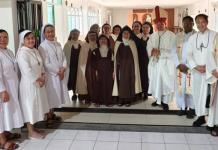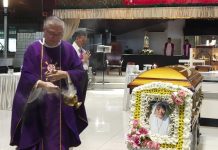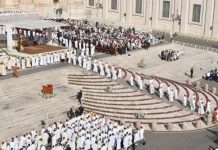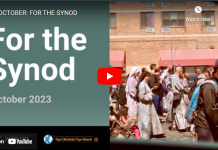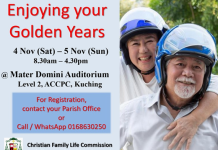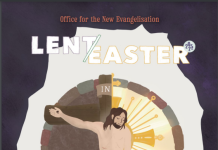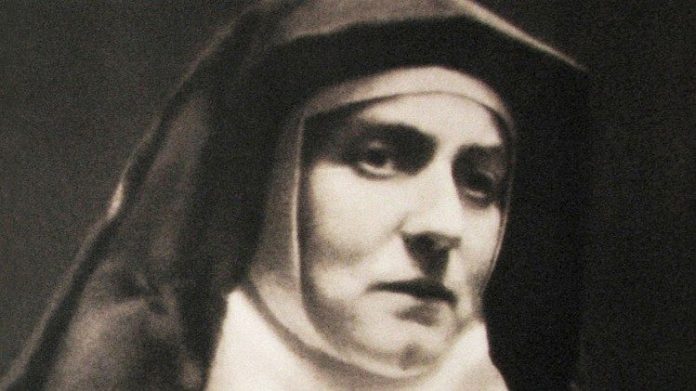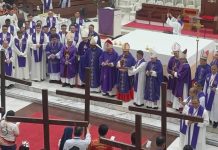By Tina McCormick
When Edith Stein entered the order of Discalced Carmelite nuns in 1933, she assumed the name of Teresa Blessed by the Cross. What did she mean by the seeming paradox of being “blessed by the cross”? It is the echo of St. Paul’s words to the Galatians: “Far be it from me to glory except in the cross of our Lord Jesus Christ (6:14).”
Stein was a brilliant and highly accomplished philosopher, writer, and teacher and a known public figure as the intellectual leader of the German Catholic women’s movement. Until 1933, her life had been one of courage and resolve as she faced the challenges of being a Jewish woman (one of the first Ph.D.s in Germany, in fact) in the male academic world of pre-Nazi Germany.
Her life had been a search for truth, which led her away from the Jewish faith of her childhood. She chose the secluded life of Carmel and accepted the vows of obedience, chastity, and poverty — or, as she called them, “the three nails of the cross,” which invites all of us to ask ourselves what our own personal cross might mean.
Stein wrote extensively about the meaning of the cross, and her last yet incomplete work before her deportation to and subsequent death at Auschwitz in 1942 was “The Science of the Cross.” Her personal lifelong journey of faith toward the cross and her decision to enter the convent are the most fascinating aspects of her life.
Through her writings, but even more by looking at her life, her choices, and her view of her own destiny, we come to a clearer understanding of the true meaning of the cross and how each one of us may share in its glory. We learn from her that our path inevitably leads us toward the cross once we embark on a journey of faith. And we learn that this cross, properly understood, is not a life of fatalism, penance, or suffering for the sake of suffering; instead, Christ’s cross is always a glorious one. Sharing in his suffering and death by dying to ourselves always points to the joys of the Resurrection and to love. Our cross, which should not lead us to defeat or inward-focused piety, must energize us and point us toward realizing our potential in order to give and love as Christ did.
We often regard the acceptance of the cross as a mere surrender to external circumstances, as a way to rationalize hardship and sometimes to justify passivity. However, Edith Stein was never one to simply accept external circumstances. She was outspoken about the importance of action and was didn’t simply accept things as they were.
She wrote: “My decisions arose out of a depth that was unknown even to myself. Once a matter was bathed in the full light of consciousness and had acquired a definite form in my thoughts, I was no longer to be deterred by anything; indeed I found it an intriguing kind of sport to overcome hindrances which were apparently insurmountable” (“Life,” 151).
As a student, and then as an academic and teacher in Germany, she showed deep concern for social responsibility and advocated full political and professional equality for women. She wrote extensively on the importance of women’s contributions to all areas of public life.
Her interior life remained hidden. Her spiritual journey occurred in a space that only God knew. When she joined the Carmel, she left her 84-year-old ailing mother whose permanent separation from her youngest and favorite daughter led to despair and despondency. The decision to leave her mother would have been a morally questionable choice by many people’s standard at the time. Her mother died of stomach cancer just two years later, never having seen her daughter again.
Yet, however tragic that may seem, Edith Stein’s decisions to, first, convert to Catholicism and later become a Carmelite nun against her mother’s wishes were based on a calling she perceived deep inside her soul, in a realm immune to human judgment.
The journey of faith upon which she embarked as a young woman of 22 brought forth an interior, deeply personal life. It caused a sense of loneliness in the world, or, as she called it, the “dark night,” through which, finally, she came face to face with God.
In a letter to a friend, she alluded to this secrecy of the soul: “I found the place where there is rest and peace for all restless hearts. How that happened is something you will allow me to be silent about today. I am not reluctant to speak about it and, at the right time, will surely do so with you also, but it has to ‘come about’: it is not something about which I can ‘report’ in a letter” (“Self-Portrait,” 47). She, in fact, never did “report” how exactly this came about.
Eventually, her personal martyrdom — understood as a dying to self — took on concrete form in the monastic life of daily sacrifice and prayer. By physically retreating from the world, leaving everything behind, she accomplished a final and deeply personal union with God.
Yet once this personal martyrdom had been achieved — in ways hidden from the world and hardly understood by her own family — she could dedicate herself to the needs of others and share the suffering of the world through prayer and contemplation.
She often wrote of the peace and tranquility of convent life and wished for nothing more than to spend her day in prayer. This was Edith Stein’s beloved and glorious cross, at rest with the Lord, rejoicing in his love, and in empathy with the world.
Even in the deportation camp on her way to Auschwitz, she was not given to surrender but sent a final plea to the Swiss consulate for a visa. She knew that the final cross would come, if God so willed. In the meantime, she remained a fighter, who loved life and snubbed evil. This was Edith Stein’s approach to the cross: Trust in God’s ultimate love and wisdom yet never simply surrender to the outer limitations of humanity’s frail existence. Such surrender to external circumstances would be like accepting the shackles of a cross of death, of defeatism and despair.
Instead, the cross leads to glory, to the resurrection, the overcoming of all death and suffering through divine love. By realizing that the cross calls us to action and joy rather than surrender, we may hope to transcend the boundaries imposed by a world built on human limitations.
To share in the glory of the cross, our actions and choices must be oriented toward increasing our personal closeness to God, to nurturing an ongoing love affair hidden in the innermost core of our being. Like Edith Stein, we must find ways to create an inner, private space to cultivate our relationship with God and enter into a mystical union of love with him. At the same time, we must find ways to bear joyful witness, to realize our potential, and to engage actively in the world as imitators of Christ and children of God. In “Science of the Cross,” she wrote that Christians in wartime Germany would act differently if “Christian doctrine and the mighty deeds of God … [were] the content of [their] life.”
The cross is a call to a living faith and fearless action. It is not for us to remain standing beneath it, grief-stricken and paralyzed by pain, embracing suffering for the sake of suffering. In Christ on the cross, God has given us all the answers. It is up to us to act on them.
According to St. John of the Cross, on whose writing Edith Stein based her own science of the cross, St. Paul, in his letter to the Hebrews, said: “Let it be understood that God has remained, as it were, mute, and that he has nothing more to say, because what he was saying in fragments by the prophets, he said in its entirety, by giving us the Whole who is his son” (SMC, No. 4, p. 201).
This “Whole” is the realization of God’s love through his Incarnation, and it is our guide for growing closer to him. On our own journey of faith and facing life’s challenges, let us remember Edith Stein’s words: “Be patient with yourself; God is.”








、尤金·玛格拉桑神父(Fr-Eugene-Maglasang)(前排右八)及叶祥胜神父(前排右十)于2025年1月25日在圣体堂合影。(摄影:蔡彼得).jpg)
